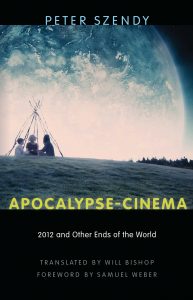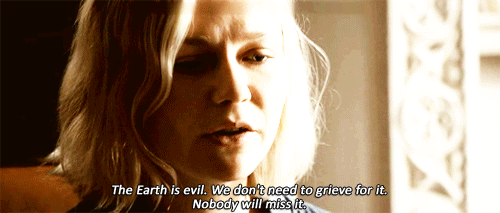The 2011 film Melancholia by director Lars Von Trier synchronizes it’s ending with the end of the world, which runs the risk of overshadowing the characters and story of the film. Peter Szendy, author of the 2015 book “Apocalypse-Cinema: 2012 and Other Ends of the World”, believes this ending is the true ending of apocalypse cinema. Szendy feels he “disappeared at the same time the last image [of the film] did,” in which he became one with the last moments during the finale; The small planet Melancholia destroys the Earth with a flash, a cloud of smoke, and the music of Wagner’s Tristan and Isolde (Szendy, 1). For Szendy, the ending embodies a “true” apocalypse genre theme: The end of the world should correspond to the end of the film itself. The majority of this chapter on Melancholia in “Apocalypse Cinema” spends a great deal of effort explaining the scene’s importance to him, but not it’s importance to the entire story.

Szendy praises the fact that that the film lets “the last image be the very last image” of “all past present and future” (Szendy, 2). Like the characters displayed in the film, the film audience too experiences a kind of “death” by cutting to black. Szendy’s experience of being “in the black screen” the film plays tribute to how the audience shares existential finality of death here (Szendy, 1). Szendy calling this image “past, present, and future” becomes erroneous in interpreting importance in Von Trier’s film and Apocalypse cinema in genre. It is erroneous in that the impact of Apocalypse is still in the before and after of the story, not the apocalyptic event itself. If you took this last image alone, you would be missing out on the rich character dynamics of Justine (Kristen Dunst) and Claire (Charlotte Gainsbourg), the sisters who hold hands with Claire’s son Leo in the final scene. You would miss Justine as she sinks into a depression spurred by the stress of her dysfunctional family, her manipulative boss Jack, and cheating on her newlywed husband with Jack’s nephew. That includes missing her apathetic- depressive personality as a result. You would not witness Claire panicking about Melancholia while her husband John dismisses her fears in a patronizing way. You would miss the confrontation in which Justine’s acceptance of the end conflicts with Claire’s fear of death. Each of these plot points reflects personal devastation within the characters themselves. The world is both literally and figuratively ending for Justine and Claire. If you, the audience, only took away the final moments of the film as Peter Szendy implies are most essential, you’re missing 99% of the actual apocalypse conversation.

“The earth is bad, we don’t need to grieve for it, nobody will miss it.” Justine concludes to Claire (Melancholia, 2011). The fact that she been hurt by Jack, and has hurt by Michael affects her. The way she mentions “Earth is bad” gives evidence to how she has distanced herself from her own reality. Justine mirrors the dysfunctional attributes of her family from the earlier in the film in her difficulty in coping with the past and present. By bringing Justine’s depression into the story as a form of apathy for everything, Lars Von Trier juxtaposes depression to the apocalypse. Justine calls Claire’s plan to spend her last moments together, “ a piece of shit” with deadpan eyes, mocking the “niceness” of her gesture (Melancholia, 2011). Justine wishes Claire to stop caring, or to “grieve for it”. Her emotional and physical state are both facing annihilation. The arrangement of the scene has dim light, which only illuminate the each actresses’ expressions. The soft classical music that transitions each scene gives the film a dream-like quality. Szendy calls the last image an “end of cinema” moment in which the film itself perishes when the world ends. Von Trier’s character and film form evoke emotions related to the apocalypse as well as

Szendy’s point on Melancholia’s final scene has merit, but his claim to it being the truest Apocalyptic film falls short by not imagining events that could complicate. A flashback would have been more meaningful. Keep in mind the ending of the ending of Matt Reeve’s Cloverfield (2008), in which the ending cuts to a found-footage flashback from before the film. He compares Melancholia’s ending to the ending of Ted Posts’s Beneath the Planet of The Apes. In Post’s film, an atomic explosion ends the world, followed by a narrator dialogue explaining the world “is now dead”. The post-film exposition was only meant to set up a sequel and is therefore not as apocalyptic as Melancholia according to Szendy. What’s wrong with events happening after the end? Can’t an apocalypse have a post-apocalypse? The point of an apocalyptic fiction’s plot isto show us the events leading up to the end and of what happens after, not to gratify us with an explosion. There is more of a narrative to an apocalypse genre fiction piece than the scene where “it all ends”, since it should be widely known that “true apocalypse” fictions are also the ones in which the narrative leads up to and continues after the end.
Sources:
Szendy, Peter. Apocalypse-Cinema: 2012 and Other Ends of the World. New York : Fordham
University Press, 2015.College Complete.
Trier, Lars von, et al. Melancholia. 2011.
Update:
I wish I had a place to put this in the rest of the blog. After writing this piece, I found two other movie that fit into Peter Szendy’s definition of the “true” apocalyptic cinema. Go watch (or rewatch) Miracle Mile (1988) with director Steve De Jarrett if you have a chance. Miracle Mile has a similar “ending”, in that a nuclear weapon is dropped on LA in the last moments of the film. Seeking a Friend For The End Of The World (2012) is another film I had forgotten about until the last minute. Will Ferrell and . It’s unfortunate that I could not rewrite the entire post in time to discuss it further, but it adds to the point that Szendy’s concept is not unique to Melancholia.
What struck me most about Melancholia and the significance of the last scene was the fact that the end is inevitable in everything we do. There is always an end and there is no stopping it once it is put in motion. As I was looking at Szendy’s book cover about the apocalypse I found myself looking at the cover and I was captured by the faint outline of a teepee that is constructed simply of far spaced branches. This simple image depicts the futile attempt to stop the end of the world and the barriers we may put up to protect ourselves, but yet they are as useless as a few sticks tied together in the face of world extinction. Speaking to your point of “letting the last image be the last image,” is the finality of the end and our inability to prevent it or change the outcome.